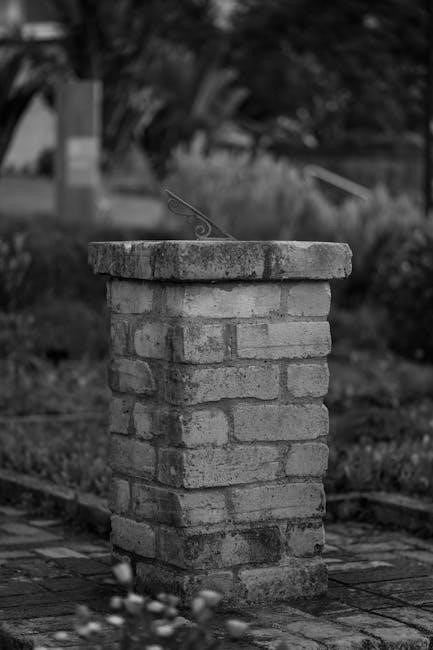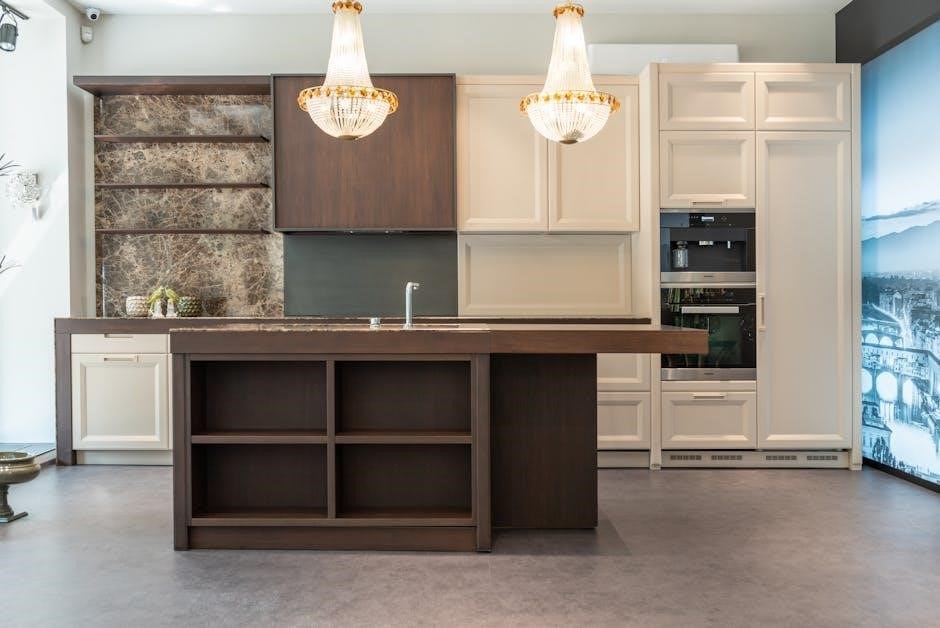Preparation Steps for Cabinet Installation
Preparation Steps for Cabinet Installation involve cleaning the area, checking all items, measuring obstructions, and positioning cabinets correctly. Ensure the space is ready for a smooth installation process.
2.1. Delivery and Unpacking
Ensure cabinets are delivered and handled carefully to avoid damage. Begin by unpacking each cabinet, checking for any visible damage or defects. Remove all packaging materials, including cardboard and plastic, and place cabinets on a protected surface. Verify all items match the inventory list and organize hardware and accessories to prevent loss or misplacement during installation.
2.2. Cleaning the Area
Clean the installation area thoroughly to ensure a smooth process. Remove debris, dust, and any obstructions from the floor and walls. Use a broom or vacuum to clear the space, and cover the floor with protective material to prevent damage. This step ensures accurate measurements and proper cabinet placement, avoiding delays or issues during installation.
2.3. Checking All Items Are Present
Verify all components are included before starting installation. Check for cabinets, shelves, doors, hardware, and mounting accessories. Refer to the packaging list or manual to ensure nothing is missing. This step prevents delays and ensures all necessary parts are available, allowing for a smooth and efficient installation process from start to finish.
2.4. Measuring and Noting Obstructions
Measure the installation area to identify any obstructions, such as electrical outlets, plumbing, or uneven surfaces. Mark these locations to ensure proper cabinet placement and alignment. Adjust your layout as needed to accommodate obstructions, ensuring a secure and stable installation. This step is crucial for avoiding issues during the mounting process.
2.5. Positioning Cabinets
Position base and wall cabinets according to your measured layout, starting from a corner for accuracy. Use a level to ensure proper alignment with walls and adjacent cabinets. Double-check the position against marked obstructions and adjust as needed for a seamless fit. Ensure all cabinets are plumb and level before securing them to the wall or floor.

Tools and Materials Needed for Installation
A cordless power drill with a #2 Philips bit, mounting hardware, and leveling legs are essential for a secure and precise cabinet installation process.
- Cordless power drill
- #2 Philips bit
- Mounting hardware
- Leveling legs
3.1. Cordless Power Drill with a #2 Philips Bit
A cordless power drill with a #2 Philips bit is essential for driving screws securely during cabinet installation. It ensures precise and efficient fastening, making the process smoother and faster. This tool is specifically recommended for its ease of use and compatibility with New Age cabinet hardware, ensuring a secure and stable installation.
- Requires a #2 Philips bit for compatibility
- Ensures precise screw driving
- Recommended for ease of use
3.2. Mounting Hardware
Mounting hardware is crucial for securing cabinets to walls, ensuring stability and safety. This typically includes wall brackets, screws, and bolts designed specifically for New Age cabinets. The hardware may vary depending on the cabinet model and weight capacity. Always use the provided mounting kit to ensure compatibility and proper installation. Follow the manufacturer’s instructions for correct hardware usage.
- Includes wall brackets and screws
- Designed for specific cabinet models
- Ensure weight capacity matches
3.3. Leveling Legs
Leveling legs are essential for stabilizing cabinets on uneven surfaces. They allow for height adjustments to ensure cabinets are perfectly aligned and secure. Proper installation involves screwing the legs into the base and adjusting them to achieve even weight distribution. Ensure legs are tightly fastened to prevent movement. Refer to the manual for specific adjustment instructions.
- Adjustable for uneven floors
- Ensure secure fastening
- Refer to manual for guidance

Securing the Cabinet to the Wall
Securing the cabinet to the wall is crucial for stability and safety. Use the pre-drilled holes to anchor the cabinet firmly, ensuring it is level before tightening the screws. This prevents tipping and ensures a sturdy installation. Always follow the manufacturer’s guidelines for the correct hardware and techniques.
4.1. Locating Punched Holes for Wall Mounting
Open the locker doors to locate the punched holes on either side of the cabinet. These holes are typically positioned 32 inches up from the inner base. Ensure you identify all mounting points before drilling to align the cabinet correctly with the wall anchors. This step ensures proper alignment and secure installation. Always refer to the manufacturer’s specifications for exact hole locations.
4.2. Drilling and Anchoring
Use a cordless drill with a #2 Philips bit to create pilot holes aligned with the punched holes on the cabinet. Insert wall anchors into the drilled holes to provide a secure base for mounting. Carefully lift the cabinet and screw it into place, ensuring it is tightly fastened to the wall. This step is crucial for stability and prevents future structural damage.

Leveling the Cabinet
Ensure the cabinet is stable by adjusting the leveling legs to achieve even balance. Use a level tool to verify alignment and make necessary adjustments for proper installation.
5.1. Adjusting Leveling Legs
Start by locating the leveling legs at the base of the cabinet. Turn the adjustment screws clockwise or counterclockwise to raise or lower the cabinet. Use a level tool to ensure the cabinet is balanced evenly. Make fine adjustments until the bubble in the level is centered, confirming proper alignment. This step is crucial for stability and preventing uneven surfaces.
5.2. Ensuring Proper Alignment
After adjusting the leveling legs, use a carpenter’s level to verify both horizontal and vertical alignment. Ensure the cabinet is plumb by checking the vertical alignment on both sides. Make final adjustments to the leveling legs to achieve perfect balance. Once aligned, tighten the legs securely. Proper alignment ensures the cabinet is stable and ready for further installation steps, such as connecting worktops or additional cabinets.
Connecting Base and Wall Cabinets
Secure base and wall cabinets using screws, ensuring proper alignment and stability. This connection enhances structural integrity and provides a seamless installation for your New Age cabinets.
6.1. Assembling Base Cabinets
Begin by carefully unpacking and organizing all components. Follow the manufacturer’s instructions to attach leveling legs and assemble the base cabinet structure. Ensure all parts are securely fastened and the cabinet is properly balanced. Position the base cabinet in its designated area and verify stability before proceeding to connect it with wall cabinets for a cohesive installation.
6.2. Securing Cabinets Together
Once base cabinets are in place, align the wall cabinets with them, ensuring proper positioning. Use the provided hardware to securely fasten the cabinets together, making sure all joints and connections are tight; Double-check the alignment and stability of the combined units to ensure a sturdy and seamless integration between base and wall cabinets for optimal functionality and appearance.
Installing Worktops and Wall Cabinets
Place worktops on base cabinets, ensuring a flush fit. Mount wall cabinets securely, aligning with base units for a seamless look. Verify proper alignment and stability before finalizing the installation to ensure a sturdy and visually cohesive setup.
7.1. Placing Worktops
Begin by carefully unpacking the worktop and positioning it on the base cabinets. Ensure the worktop is aligned with the cabinet edges and fits snugly. Check for levelness and make adjustments as needed using shims or leveling tools. Secure the worktop firmly to the base cabinets to create a stable and even surface. Double-check the alignment before proceeding to ensure a seamless fit.
7.2. Mounting Wall Cabinets
Locate the punched holes on the back of the wall cabinet for mounting. Drill pilot holes into the wall at the marked positions and insert wall anchors. Carefully lift the cabinet, aligning it with the holes, and secure it using screws. Ensure the cabinet is level and stable before tightening the screws completely. Double-check the alignment and stability to ensure a proper fit and safety.

Mounting Hardware and Shelves
Mount hardware and shelves by attaching brackets to the cabinet interior. Ensure proper alignment and secure all components tightly. Follow manufacturer instructions for precise installation.
8.1. Installing Shelves
Begin by carefully placing shelves inside the cabinet, ensuring they fit snugly into the pre-drilled shelf pin holes. Align the shelf brackets with the holes, securing them firmly with screws. Double-check the shelf’s levelness and stability before adding any weight. Follow the manufacturer’s instructions for specific shelf height adjustments to maximize storage efficiency and accessibility.
8.2. Securing Hardware
Attach handles, knobs, or other hardware to the cabinets using the provided screws. Ensure all hardware is tightly secured and properly aligned. Double-check the screw tightness to prevent loosening over time. Follow the manufacturer’s instructions for specific hardware requirements, ensuring a sturdy and functional installation that enhances the cabinet’s durability and user experience.
Safety Tips and Precautions
Always wear protective gloves and safety glasses. Use proper lifting techniques to avoid injury. Ensure the area is clear and stable. Work with a partner when moving heavy cabinets. Follow all manufacturer instructions to prevent accidents and ensure stability. Anchor cabinets securely to prevent tipping.
9.1. Using Proper Lifting Techniques
Always bend at the knees, not the waist, to lift cabinets. Keep the load close to your body and maintain a firm grip. Ensure the path is clear and avoid twisting. Use a second person for heavy items to prevent strain. Take regular breaks to avoid fatigue. Proper lifting prevents back injuries and ensures a safe installation process.
9.2. Ensuring Stability
Ensure cabinets are securely anchored to the wall to prevent tipping. Use the provided mounting hardware and double-check all connections; Verify weight limits and distribute loads evenly. Leveling legs should be adjusted to maintain balance on uneven surfaces. Regularly inspect bolts and screws for tightness. Stability is crucial for safety and long-term durability of your New Age cabinets.
Troubleshooting Common Issues
Identify and resolve common installation issues like misalignment or uneven surfaces. Use a level and drill to adjust or secure components. Refer to the manual for specific solutions to ensure proper installation and functionality of your New Age cabinets.
10.1. Addressing Uneven Surfaces
Assess the surface with a level to identify uneven areas. Adjust leveling legs to compensate, ensuring stability. Use shims under low spots for alignment. Secure cabinets firmly after leveling to prevent shifting or falling. Consult the manual for specific guidance on handling uneven surfaces effectively during installation.
10.2. Fixing Misalignment
Identify misalignment by checking the cabinets with a level. Adjust leveling legs or shims to realign surfaces. Ensure all mounting hardware is securely tightened after adjustments. Verify proper alignment and stability before finalizing the installation. Consult the manual for specific techniques to correct misalignment effectively and maintain structural integrity.
Maintenance and Upkeep
Regular cleaning and inspections ensure long-lasting durability and functionality of your New Age cabinets. Wipe surfaces with a mild detergent to maintain their appearance. Check hardware and tighten screws if necessary. Inspect for wear or damage, addressing issues promptly. Proper upkeep prevents deterioration and ensures the cabinets remain stable and functional for years to come. Refer to the owner’s manual for specific care recommendations.